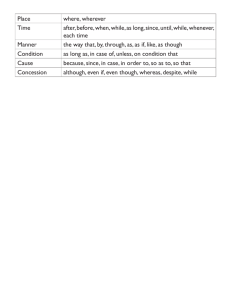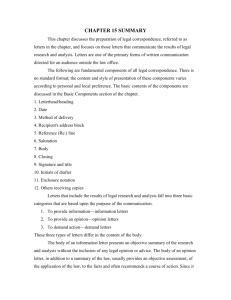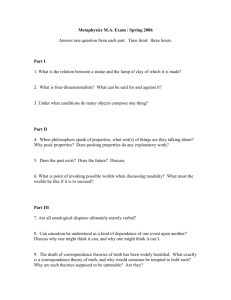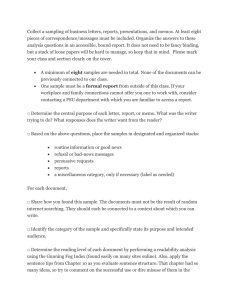MA3486, Sample Paper 2016 Worked Solutions to Selected Parts David R. Wilkins
advertisement
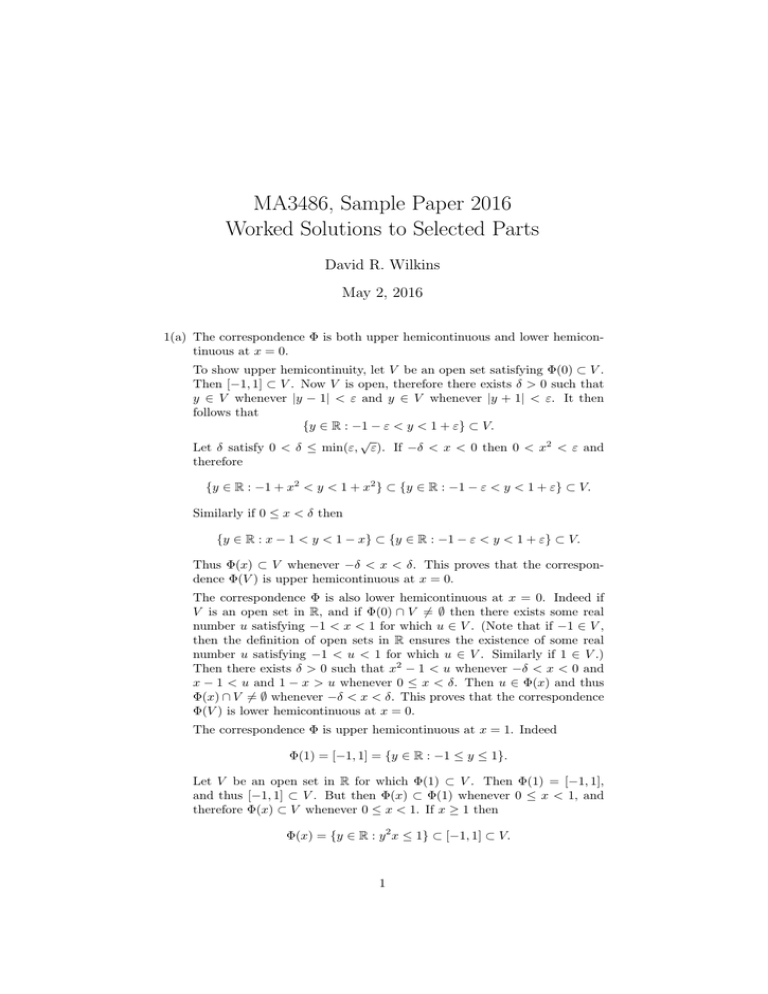
MA3486, Sample Paper 2016
Worked Solutions to Selected Parts
David R. Wilkins
May 2, 2016
1(a) The correspondence Φ is both upper hemicontinuous and lower hemicontinuous at x = 0.
To show upper hemicontinuity, let V be an open set satisfying Φ(0) ⊂ V .
Then [−1, 1] ⊂ V . Now V is open, therefore there exists δ > 0 such that
y ∈ V whenever |y − 1| < ε and y ∈ V whenever |y + 1| < ε. It then
follows that
{y ∈ R : −1 − ε < y < 1 + ε} ⊂ V.
√
Let δ satisfy 0 < δ ≤ min(ε, ε). If −δ < x < 0 then 0 < x2 < ε and
therefore
{y ∈ R : −1 + x2 < y < 1 + x2 } ⊂ {y ∈ R : −1 − ε < y < 1 + ε} ⊂ V.
Similarly if 0 ≤ x < δ then
{y ∈ R : x − 1 < y < 1 − x} ⊂ {y ∈ R : −1 − ε < y < 1 + ε} ⊂ V.
Thus Φ(x) ⊂ V whenever −δ < x < δ. This proves that the correspondence Φ(V ) is upper hemicontinuous at x = 0.
The correspondence Φ is also lower hemicontinuous at x = 0. Indeed if
V is an open set in R, and if Φ(0) ∩ V 6= ∅ then there exists some real
number u satisfying −1 < x < 1 for which u ∈ V . (Note that if −1 ∈ V ,
then the definition of open sets in R ensures the existence of some real
number u satisfying −1 < u < 1 for which u ∈ V . Similarly if 1 ∈ V .)
Then there exists δ > 0 such that x2 − 1 < u whenever −δ < x < 0 and
x − 1 < u and 1 − x > u whenever 0 ≤ x < δ. Then u ∈ Φ(x) and thus
Φ(x) ∩ V 6= ∅ whenever −δ < x < δ. This proves that the correspondence
Φ(V ) is lower hemicontinuous at x = 0.
The correspondence Φ is upper hemicontinuous at x = 1. Indeed
Φ(1) = [−1, 1] = {y ∈ R : −1 ≤ y ≤ 1}.
Let V be an open set in R for which Φ(1) ⊂ V . Then Φ(1) = [−1, 1],
and thus [−1, 1] ⊂ V . But then Φ(x) ⊂ Φ(1) whenever 0 ≤ x < 1, and
therefore Φ(x) ⊂ V whenever 0 ≤ x < 1. If x ≥ 1 then
Φ(x) = {y ∈ R : y 2 x ≤ 1} ⊂ [−1, 1] ⊂ V.
1
Thus Φ(x) ⊂ V for all x ≥ 0, and thus there exists δ > 0 such that Φ(x) ⊂
V for all x satisfying |x − 1| < δ. This proves that the correspondence
Φ(V ) is lower hemicontinuous at x = 1.
The correspondence Φ is not lower hemicontinuous at x = 1. Indeed let
V = {y ∈ R : −1 < y < − 21 }.
Then Φ(1) ∩ V 6= ∅. But if
therefore Φ(x) ∩ V = ∅.
1
2
< x < 1 then y > − 12 for all y ∈ Φ(x) and
2(c) We need to find non-negative real numbers t0 , t1 and t2 such that
(3, 3) = t0 (−1, 0) + t1 (3, 2) + t2 (4, 4)
and t0 + t1 + t2 = 1. Thus
−t0 + 3t1 + 4t2 = 3,
2t1 + 4t2 = 3,
t0 + t1 + t2 = 1.
Adding the first and third of the above equations, we see that 4t1 +2t2 = 2,
and therefore
1 = 2(4t1 + 2t2 ) − (2t1 + 4t2 ) = 6t1 ,
and thus t1 = 61 . It then follows that 2t2 = 2 − 23 , and therefore t2 = 23 .
Using t0 + t1 + t2 , we see that t0 = 61 .
2(d) Looking at the sizes of the barycentric coordinates of x, and ranking them
in increasing order, it becomes clear that the vertices of τ will be w0 , w1
and w2 , where
w0 = 14 (v0 + v1 + v3 + v4 ),
w1 = 31 (v0 + v3 + v4 ),
w2 = v3 .
(Only in this way can we achieve a representation of x as a linear combination of barycentres of faces of σ, with positive coefficients that sum up
to one.) Then
x
=
=
1
6 (v0 + v1 + v3 + v4 )
2
1
1
3 w0 + 4 w1 + 12 w2
+
1
12 (v0
+ v3 + v4 ) +
1
12 v3
1
are the barycentric coordinates of x with respect to the
Thus 23 , 41 and 12
vertices w0 , w1 , w2 of τ .
2
